![]()
![]()
![]()
Use LEFT and RIGHT arrow keys to navigate between flashcards;
Use UP and DOWN arrow keys to flip the card;
H to show hint;
A reads text to speech;
81 Cards in this Set
- Front
- Back
|
When sailing, always be aware of the wind's _____ and _____. |
speed, direction |
|
|
The desirable force generated by the wind moving across a sail is called ________. |
lift |
|
|
The direction relative to the wind in which the sailboat cannot sail is called the _____ _____ _____. |
no-sail zone |
|
|
Sailboats can reach an upwind destination by sailing a ______ curve. |
zigzag |
|
|
The point of sail at the edge of the no-sail zone is called ______ ______. |
close-hauled |
|
|
A boat sailing across the wind is said to be _______. |
reaching |
|
|
Sailing straight downwind is called _______. |
running |
|
|
As the sailboat's direction changes relative to the wind, so should the sail's ______ to the wind be adjusted. |
angle (or trim) |
|
|
The combination of the true wind and the wind created by the boat's motion (that we feel on the boat) is called _______ wind. |
apparent |
|
|
The _______ is an underwater fin fixed on the bottom of the sailboat that provides stability and lateral resistance. |
keel |
|
|
The sailboat's direction through the water is controlled by the _______, which can be turned by means of either a ______ or a ______ ______. |
rudder, tiller, steering wheel |
|
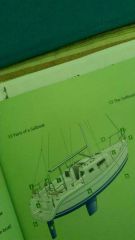
Parts of a sailboat |
a. transom b. stanchion c. deck d. helm, (tiller or wheel) e. rudder f. bow g. lifeline h. stern i. cockpit j. pulpit k. hull |
|
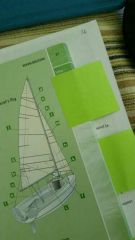
The Sailboat's Rig |
a. boom b. mainsail c. jibsheet d. mast e. mainsheet f. halyard g. boom vang h. shroud i. headsail/jib j. boom topping lift k. gooseneck l. backstay m. spreader n. headstay/forestay |
|
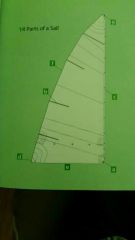
Parts of a Sail |
a. tack b. batten c. luff d. clew e. foot f. leech g. head |
|
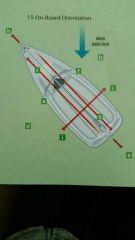
On-Board Orientation |
a. port b. windward c. forward d. leeward e. astern f. starboard g. aft h. ahead i. abeem |
|
|
The mainsail should be raised when the sailboat is oriented ______ to ______. |
head, wind |
|
|
When turning the boat toward the wind, the sails should be ______ in. |
trimmed |
|
|
When turning the boat away from the wind, the sails should be ______ out. |
eased |
|
|
"Fluttering" sails are said to be ______. |
luffing |
|
|
The best way to steer the boat on a straight course is to look toward the _____ and pick a _____ to steer toward. |
shore, landmark |
|
|
When you turn the bow of the boat toward the wind you are _____ _____. |
heading up |
|
|
When you turn the bow of the boat away from the wind you are _____ _____. |
bearing away |
|
|
The "golden rule" of sail trim is: "when in ______, let it ______." |
doubt, out |
|
|
When the boat is stopped, pointed toward the wind with the sails luffing, it is said to be _____ _____. |
in irons |
|

Points of a Sail |
a. close reach b. broad reach c. close-hauled d. run e. beam reach f. in irons/no-sail zone |
|
|
When the wind is blowing on the port side, the boat is said to be sailing on a _____ _____. |
port tack |
|
|
When the wind is blowing on the starboard side, the boat is said to be sailing on a _____ _____. |
starboard tack |
|
|
Turning the boat so the bow passes through the wind, bringing the wind to blow onto the opposite side of the boat, is called ______. |
tacking |
|
|
Changing tacks by turning the boat so its stern passes through the wind is called _____. |
jibing |
|
|
The helmsman's commands for tacking the boat (also called "coming about") are "_____ _____" and "_____ _____." |
"Ready about," "Helm's a-lee." |
|
|
The helmsman's commands for jibing the boat are "_____ to _____" and "_____-_____." |
"Prepare to jibe," "Jibe-ho." |
|
|
To jibe safely, it's very important to _____ the _____ in toward the centerline as the boat bears away onto a run. |
trim, mainsail |
|
|
Sailing on a run with the mainsail and jib on opposite sides of the boat is called sailing _____ on _____. |
wing, wing |
|
|
If the wind is on the same side of the boat as the mainsail while sailing downwind, the boat is said to be _____ by the _____. |
sailing, lee |
|
|
The danger of sailing by the lee is the increased risk of an _____ _____. |
accidental jibe |
|
|
The fastest way to change the sail's power is to change its _____ to the _____. |
angle, wind |
|
|
The shape of the mainsail may be changed by adjusting tension in the edges of the sail. Match the sail control with the edge of the sail it affects: a. Outhaul b. Halyard/downhaul/ Cunningham c. Boom vang * Luff * Leech * Foot |
a. Outhaul affects the foot. b. Halyard affects the luff. c. Boom vang affects the leech. |
|
|
The outhaul changes the depth of the _____ of the mainsail. |
draft |
|
|
Tightening the downhaul or Cunningham moves the draft of the mainsail ______. |
forward |
|
|
Tightening the _____ _____ holds the boom down on a downwind point of sail. |
boom vang |
|
|
To get full power and optimum use out of the mainsail, _____ it until it just starts to luff, then trim the mainsail in so it just stops _____. |
ease, luffing |
|
|
Two ways to change the sail's angle to the wind are: a. _____ or _____ the sail. b. _____ _____ or _____ _____. |
a. ease, trim b. head up, bear away |
|
|
The tendency for the boat to head up toward the wind on its own is called ______ helm. |
weather |
|
|
The tendency for the boat to bear away from the wind on its own is called ______ helm. |
lee |
|
|
While sailing close-hauled, four ways to decrease the heel of the boat are: a. Move the crew to the _____ side of the boat. b. _____ _____ slightly, into the edge of the no-sail zone. c. _____ the main _____. d. Move the _____ to leeward. |
a. windward b. head up c. ease, sheet d. traveler |
|
|
Reducing the size of a sail so that less area is exposed to the wind is called ______. |
reefing |
|
|
Match the following knots and hitches to their primary purpose or usage: a. Bowline b. Figure 8 c. Square knot d. Cleat hitch e. Clove hitch f. Round turn and 2 half hitches * Tie two ends of a line together * More secure tie-up to dock piling * Form a non-slipping loop, tie jib sheets to clew of jib * Keep line from slipping through a fairlead or block * Secure a dock line to a horn cleat * Temporarily tie-up to dock piling, attach fenders to stanchion |
a. Bowline: Form a non-slipping loop, tie jib sheets to clew of jib b. Figure 8: Keep line from slipping through a fairlead or block c. Square knot: Tie two ends of a line together d. Cleat hitch: Secure a dock line to a horn cleat e. Clove hitch: Temporarily tie-up to dock piling, attach fenders to stanchion d. Round turn and 2 half hitches: More secure tie-up to dock piling |
|
|
When you want a break while sailing, you can make the boat lie, ______-______. |
hove-to |
|
|
You heave-to by backing the ______, easing the ______, and putting the ______ to leeward. |
jib, mainsail, helm (tiller) |
|
|
a. _____ _____ secures the bow of the boat to the dock. b. _____ _____ secures the stern of the boat to the dock. c. _____ _____ keeps the boat from moving aft. d. _____ _____ keeps the boat from moving forward. |
a. bow line b. stern line c. forward spring d. aft spring |
|
|
______ are used to protect the hull from contact with the dock or other boats. |
fenders |
|
|
The ideal point of sail on which to approach a mooring ball is on a _____ _____. |
close reach |
|
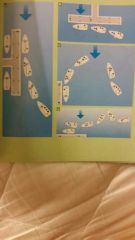
Which of the illustrations shows the best conditions under which to approach a dock under sail? a. b. c. or d. |
a. upwind approach |
|
|
In the Navigation Rules, Rule 5 (the "Lookout Rule") requires all vessels to maintain a proper lookout using _____ and _____ and any other available means (e.g., radar) |
sight, hearing |
|
|
It is the responsibility of every vessel operator to avoid a _____. |
collision |
|
|
The _____-_____ vessel's obligation is to maintain _____ and speed. |
stand-on, course |
|
|
The _____-_____ vessel is required to maneuver out of the way of stand-on vessel. |
give-way |
|
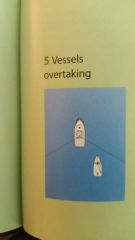
A vessel overtaking another vessel must _____ _____ to the vessel being overtaken.
|
give-way |
|
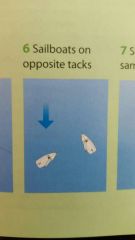
When two sailing vessels are approaching on opposite tacks, the vessel with the wind on the ______ side is the stand-on vessel.
|
starboard |
|
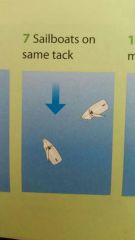
When two vessels are sailing with the wind on the same side, the vessel to _____ is the give-way vessel. |
windward |
|
|
When a sailboat has its engine running and in gear, it is defined as a _____-_____ vessel, regardless of whether the sails are raised. |
power-driven |
|
|
A powerboat, not in a channel or restricted in its ability to maneuver, should _____ _____ to a sailboat under sail, unless the sailboat is _____ the poweboat. |
give-way, overtaking |
|
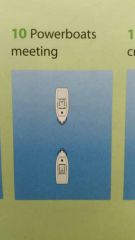
When two power-driven vessels are meeting head-on, _____ boat is the stand-on vessel. Instead, both vessels should alter course to _____ and pass port-to-port. |
neither, starboard |
|

In a crossing situation, if powerboat A sees powerboat B on its starboard side, then powerboat A shall _____ _____. |
give-way |
|
|
The give-way vessel shall take _____ and _____ action to keep clear. If the give-way vessel does not seem to be taking early or substantial enough action, then the _____-_____ vessel must take action to avoid the collision. |
early, substantial, stand-on |
|
|
Nearly all vessels must be _____ with the state in which they operate, and/or _____ through the U.S. Coast Guard Vessel Documentation Center. |
registered, documented |
|
|
There must be at least one Type I, II, III, or V _____ _____ on board for _____ person. |
life jacket (or PFD), each |
|
|
Examples of visual distress signals include: a. _____ b. _____ _____ c. _____ _____ d. _____ _____ ______ |
a. flares b. smoke signals c. distress flag d. electric distress light |
|
|
An _____ _____ can serve as a sound-producing device. |
air horn |
|
|
Any sailboat under 26 feet in length with an engine must carry a _____ _____. |
fire extinguisher |
|
|
A sailing vessel over 23 feet in length under way at night or in restricted visability is required to display a _____ sidelight on the port side, a green sidelight on the _____ side, and a _____ light on the stern. |
red, starboard, white |
|
|
When a sailboat 23 feet or longer is navigating at night with its engine operating in gear it must also display a white _____ light in addition to the sidelights and stern light. |
steaming |
|
|
The Federal limit for blood alcohol content is _____ percent. |
0.08 |
|
|
In the Aids to Navigation system, a _____ is a floating aid anchored to the bottom. A beacon is a _____ mark and can be on land or in the water. |
buoy, fixed |
|
|
Lateral Aids to Navigation are identified by three features, _____, _____, and _____. |
color, shape, number |
|
|
A way to remember on which side to keep the starboard-hand (red) markers when entering a channel from seaward is the phrase "_____ _____ _____." |
"red right returning" |
|
|
A _____ _____ buoy has red and white vertical stripes and is safe to pass on either side. |
safe water |
|
|
The procedure for recovering a crewmember who has fallen overboard (a MOB), is: a. Appoint someone as a _____ to keep the MOB in sight. b. Throw _____ device(s) to the MOB. c. Maneuver the boat back to the MOB and approach on a _____ _____ point of sail. d. Stop the boat by _____ the sails and bring the MOB aboard. |
a. spotter b. flotation c. close reach d. luffing |
|
|
The Figure-8 recovery method works well on small boats since there is no ______, thereby reducing the risk of a second MOB. |
jibe |
|
|
Checking the _____ forecast is one of the most important steps to take before going sailing. |
weather |
|
|
A _____ plan can be provided to a friend or relative who is willing to be responsible for contacting the authorities if you do not make contact on schedule. |
float plan |

